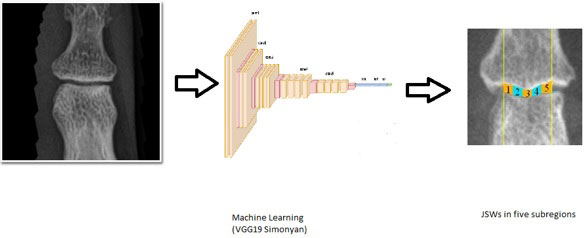Session Information
Date: Sunday, November 13, 2022
Title: Research Methodology Poster
Session Type: Poster Session B
Session Time: 9:00AM-10:30AM
Background/Purpose: Hand osteoarthritis (OA) can be assessed visually through radiographs using Kellgren and Lawrence (KL) system. However, the KL grading system is not fully objective and cannot distinguish minor differences. Although joint space width (JSW) measuring compensates for these disadvantages, current semi-automated JSW measurement methods are time-consuming and financially costly. In this abstract, we introduced a machine learning (ML) approach, which employs two multi-output regression convolutional neural networks (CNNs) to automatically measure JSW in 5 subregions on each finger joint (12 joints from a hand radiograph).
Methods: We selected 3,591 hand X-rays from the Osteoarthritis Initiative (OAI). We first used our previously developed automated joint detection pipeline to identify 41,060 joints. An existing semi-automated labeling method was used to establish the ground truth for training and testing. In this study, we used a total of 10,845 distal interphalangeal (DIP) joints, including 576 DIP joints that we selected as a testing set for the ML model method. We then split the other DIP joints (10,269) into a training set and a validation set by a ratio of 0.8 for training and 0.2 for validation. The ML method took the X-ray finger joint segmentation (measurement region) and the KL grade as input. Next, the ML method measured five JSW measurements directly using two multi-output regression CNN models: The non-OA model for KL grade 0 or 1, and the OA model for KL grade 2 to 4. Both models were built on top of regular VGG-19 architecture. We trained each model for 1,000 epochs using Mean Square Error (MSE) as the loss function and optimized using Adaptive moment estimation (Adam) with a learning rate of 10-5.
Results: Table 1 lists the Pearson correlation (r), MSE, and average JSW in millimeters for the ML method along with the ground truth from the semi-automated software. The method achieved the highest correlation coefficient of 0.89 and the smallest MSE of 0.013 mm for the KL=0 group. In general, the ML method performs better in healthy (KL= 0 ∼ 1) compared to severe (KL= 3 ∼ 4) joints.
Conclusion: JSW measurement is oftentimes more applicable for examining hand OA than the KL system because of its ability to monitor small positive or negative changes. In this study, we reported an ML-based approach to obtain five JSW measurements automatically from the radiographs, which is more efficient than the current method. The method achieves good correlation and small MSE with the manual JSW among hands with no or minimal hand OA. This work has the potential to improve the efficiency of hand OA research studies. In future studies, we will extend the ML models to measure proximal interphalangeal and metacarpophalangeal finger joints.
To cite this abstract in AMA style:
Chang Z, Shan J, Wang Y, Sun X, Driban J, McAlindon T, Duryea J, Schaefer L, Eaton C, Zhang M. Automated Joint Space Width Measurement for Hand Osteoarthritis: A Deep Learning Approach [abstract]. Arthritis Rheumatol. 2022; 74 (suppl 9). https://acrabstracts.org/abstract/automated-joint-space-width-measurement-for-hand-osteoarthritis-a-deep-learning-approach/. Accessed .« Back to ACR Convergence 2022
ACR Meeting Abstracts - https://acrabstracts.org/abstract/automated-joint-space-width-measurement-for-hand-osteoarthritis-a-deep-learning-approach/


